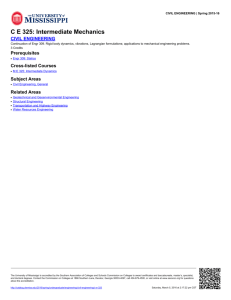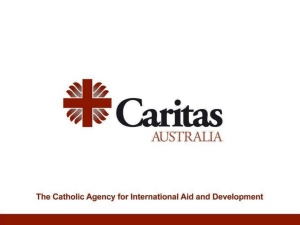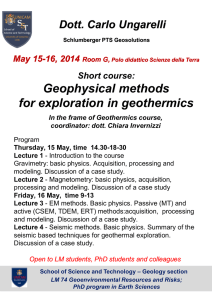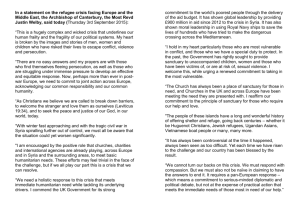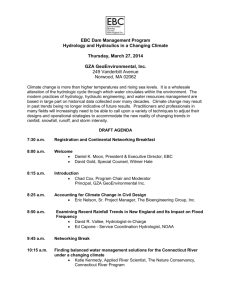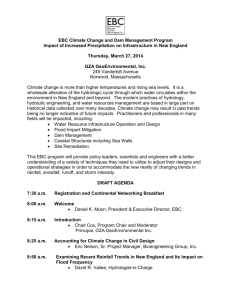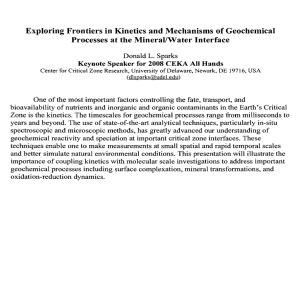THE ROLE OF REMOTE SENSING DATA IN STUDYING ENVIRONMENTAL
advertisement
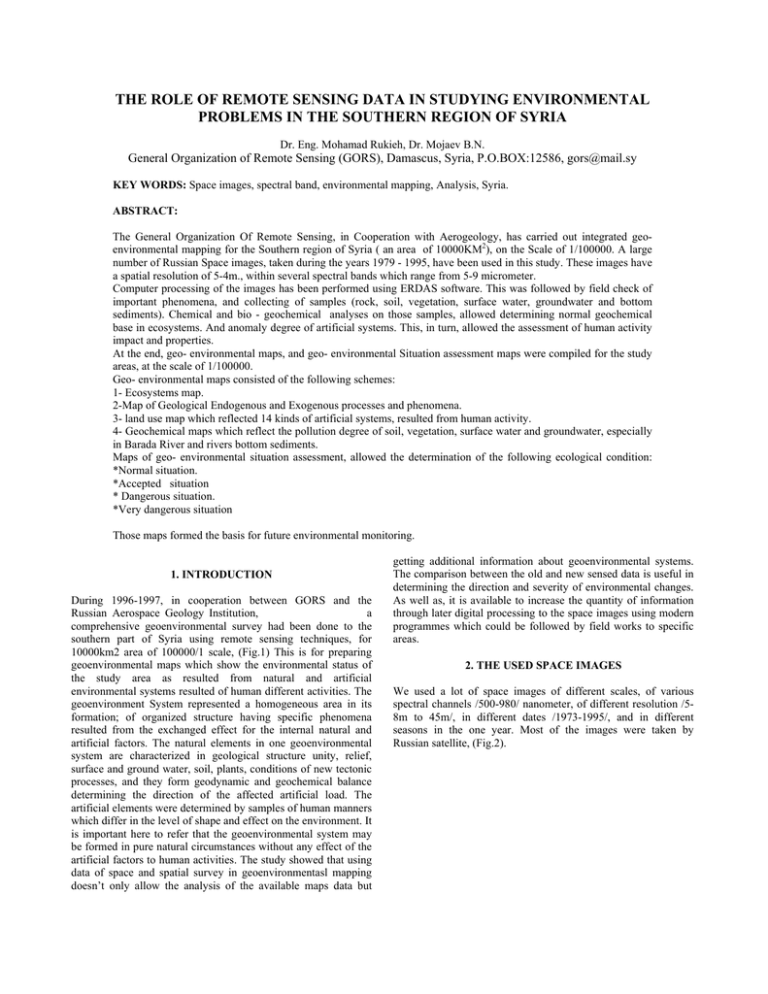
THE ROLE OF REMOTE SENSING DATA IN STUDYING ENVIRONMENTAL PROBLEMS IN THE SOUTHERN REGION OF SYRIA Dr. Eng. Mohamad Rukieh, Dr. Mojaev B.N. General Organization of Remote Sensing (GORS), Damascus, Syria, P.O.BOX:12586, gors@mail.sy KEY WORDS: Space images, spectral band, environmental mapping, Analysis, Syria. ABSTRACT: The General Organization Of Remote Sensing, in Cooperation with Aerogeology, has carried out integrated geoenvironmental mapping for the Southern region of Syria ( an area of 10000KM2), on the Scale of 1/100000. A large number of Russian Space images, taken during the years 1979 - 1995, have been used in this study. These images have a spatial resolution of 5-4m., within several spectral bands which range from 5-9 micrometer. Computer processing of the images has been performed using ERDAS software. This was followed by field check of important phenomena, and collecting of samples (rock, soil, vegetation, surface water, groundwater and bottom sediments). Chemical and bio - geochemical analyses on those samples, allowed determining normal geochemical base in ecosystems. And anomaly degree of artificial systems. This, in turn, allowed the assessment of human activity impact and properties. At the end, geo- environmental maps, and geo- environmental Situation assessment maps were compiled for the study areas, at the scale of 1/100000. Geo- environmental maps consisted of the following schemes: 1- Ecosystems map. 2-Map of Geological Endogenous and Exogenous processes and phenomena. 3- land use map which reflected 14 kinds of artificial systems, resulted from human activity. 4- Geochemical maps which reflect the pollution degree of soil, vegetation, surface water and groundwater, especially in Barada River and rivers bottom sediments. Maps of geo- environmental situation assessment, allowed the determination of the following ecological condition: *Normal situation. *Accepted situation * Dangerous situation. *Very dangerous situation Those maps formed the basis for future environmental monitoring. 1. INTRODUCTION During 1996-1997, in cooperation between GORS and the Russian Aerospace Geology Institution, a comprehensive geoenvironmental survey had been done to the southern part of Syria using remote sensing techniques, for 10000km2 area of 100000/1 scale, (Fig.1) This is for preparing geoenvironmental maps which show the environmental status of the study area as resulted from natural and artificial environmental systems resulted of human different activities. The geoenvironment System represented a homogeneous area in its formation; of organized structure having specific phenomena resulted from the exchanged effect for the internal natural and artificial factors. The natural elements in one geoenvironmental system are characterized in geological structure unity, relief, surface and ground water, soil, plants, conditions of new tectonic processes, and they form geodynamic and geochemical balance determining the direction of the affected artificial load. The artificial elements were determined by samples of human manners which differ in the level of shape and effect on the environment. It is important here to refer that the geoenvironmental system may be formed in pure natural circumstances without any effect of the artificial factors to human activities. The study showed that using data of space and spatial survey in geoenvironmentasl mapping doesn’t only allow the analysis of the available maps data but getting additional information about geoenvironmental systems. The comparison between the old and new sensed data is useful in determining the direction and severity of environmental changes. As well as, it is available to increase the quantity of information through later digital processing to the space images using modern programmes which could be followed by field works to specific areas. 2. THE USED SPACE IMAGES We used a lot of space images of different scales, of various spectral channels /500-980/ nanometer, of different resolution /58m to 45m/, in different dates /1973-1995/, and in different seasons in the one year. Most of the images were taken by Russian satellite, (Fig.2). 3. THE DIGITAL PROCESSING OF THE SPACE IMAGES The processing had been done by Sun station using ERDAS programme. The following data had been processed -MCY data, 1995 which represented 6 images in three spectral bands registered digitally, and collected in one image for each spectral field. - MCY 1992 data, image in three spectral fields registered digitally in addition to using filters in order to removal the deformation. -Photographic space image taken by MK4 camera loaded on Resource F1 satellite and composed of two images in two spectral bands /640-690/ to /810-900/ nanometer, 800000/1 scale. The images had been changed to digital values keeping the resolution 7m. These data had been joint through referential points, and the necessary geometrical correction were made, this is a main process for showing the composite images later. The mechanical processing was made by using two main methods: 1- synthesis color for three spectral channels with (red, green, and blue). (Fig.3). 2- colour symbolizing processes for specific narrow fields or for parts of them. Fig (1) Orographic map with Geoenvironmental regions Fig (3) false colour compose space image from Resource 01 (1995) shows pre rift, Antilebanon, Damascus basin with high wetness in Gota (black colour) 4. PREPAING THE GEOENVIRONMENTAL MAPS Fig (2) Color Russian space image covers the study area and show the natural Geoenvironmental system (I, II, III, IV) Geoenvironmental maps had been prepared for a number of sheets to the study areas of 100000/1 figs. (1, 4), each of them consisted of many sections , the most important: a- Natural environmental system maps which reflect the natural characteristics and the geodynamic stability degree towards physical and mechanical effects, as well as towards soil pollution. Where a determining to four main geoenvironmental areas had been done: 1- the area of front rift, 2- eastern Lebanon series and Al-Kalamoun (Antilebanon), 3- western Palmyrides, 4- southern volcanic area and Damascus basin (Jabal El-Arab). In addition to distinguish more than fifty primary environmental system. (Figs.1,2) b- c- d- Phenomena and external and internal geological processes maps which reflect the tectonic breaks and active faults by which seismic zones are connected. As well as they show the parts in which external processes like sliding, erosion, carst, phenomena of wind effect, wetness, saltiness… etc are activated. Land use maps which demonstrate 14 kinds of artificial systems resulted from human activities. Maps of toxic and geochemical analysis results which show the pollution degree of soil, plants, surface and ground water and deep sediments. 6. RESULTS For the first time in Syria, a group of geoenvironmental maps for the southern part of Syria had been prepared of 100000/1 using remote sensing data and field works which showed the recent environmental status in south of Syria and give the following: 1-More comprehensive estimation to the study area status. 2- determining the characteristics of the environmental deformation through group of quantitative and ualitative factors, as well as defining the pollution degree of different environmental surroundings such as: soil, plants, surface and ground water, deep sediments..etc. 3-dividing the natural environmental milieu to four samples: stable, accepted, moderately and threatened. 4-Estimation of geoenvironmental ability through geochemical and geodynamic stability degree in addition to preparing map of geoenvironmental ability and status of milieu. 5- Determining the dangerous area which is characterized by huge pollution, it covers part of Damascus and its surroundings, Ghota, Darya, Doma, Qatana and industrial areas. 6- showing the boundary of the huge anomalous zones through space images. 7- Determining the natural factors which cause desertification. And the role of human activity in this processes which include: climate dryness, low surface flow, saltiness of deep and surface soil, formation of carbonate and plaster crust on the surface of land, and plant rarefaction which is represented by: arbitrary grazing in the low productive grassland. Retraction of forestry. Irregular irrigation to the arable lands. The strong active of cities growth, industrial production…etc. We can say in general that Damascus is in moderately and threatened geoenvironmental status whereas the very dangerous status. REFERENCES Fenogradov.B.F, 1984 “Aerospace Monitoring for the Environmental Systems”, Moscow,. Fig (4) Geoenvironmental map of the southern region in Syria 5. ESTIMATION OF THE GEOENVIRONMENTAL STATUS OF THE STUDY AREA Geoenvironmental estimation maps had been prepared to the southern part of Syria depending on the natural geoenvironmental ability and the deformation degree of the natural environment, where determining the degree of deformation and anomalous through studying new space images, whereas determining the pollution degree had been done through geochemical and toxic analysis research. The geoenvironmental ability had been divided to 9 groups depending on geochemical and geodynamic stability degree. As a sequence four main cases to environment had been distinguished: normal, accepted, dangerous and very dangerous. Bonikarov, 1966 “The Geological Map for Syria”,. “The Use of Water Resources for Barada and AlAwag Basins for Irrigation purposes in Syria”. 1986. A group of Russian experts, Lenengrad,. Kouzolov. F.F, 1966. “The History of Geologic Development in Neogene, Quaternary and the Recent Tectonic in Syria”, Moscow. Mernova. A.F, 1994 . “The Joint Use Technique of Aero spatial Data and the Results of Environmental Research”, Moscow. Mernova. A.F, 1994. “Remote Sensing and Geoenvironmental Mapping Depending on Space Images”, Moscow.

